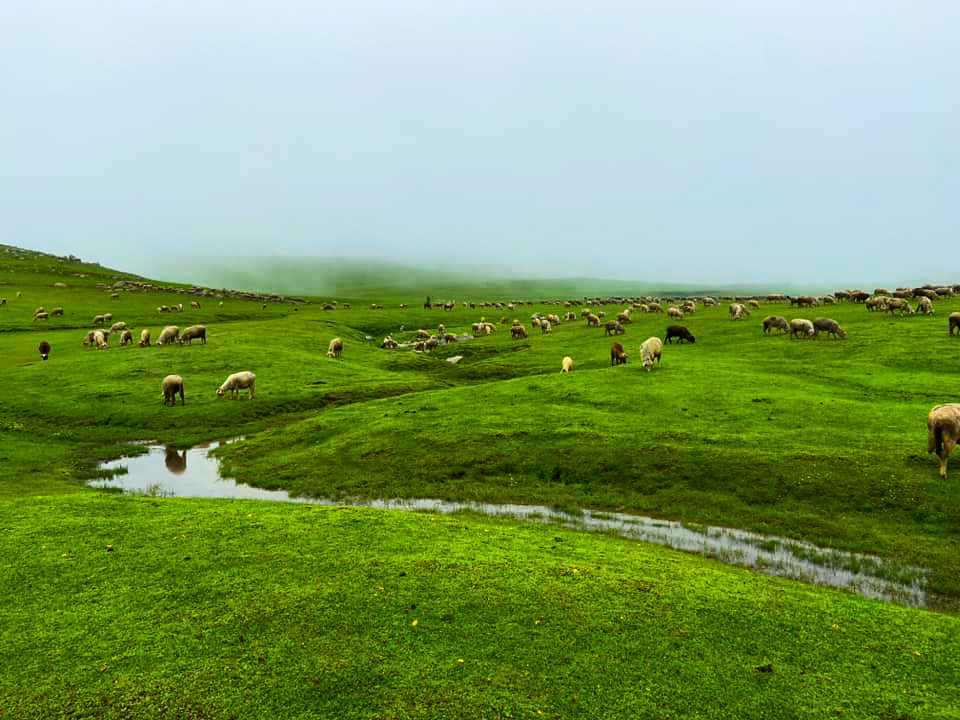The next day started on a gloomy note. It was cloudy and rainy, and the visibility was very poor. However, since we just had to move on towards Yousmarg, we packed up our tents, loaded the horse, and started a long trek towards Chanze meadow. That was our fourth day of the trek and we had been wet for the third consecutive day. Our shoes by now were too soaked to get dry and whenever we sat near a stove, wisps of smoke rose from them. They became heavy with moisture and I hated slipping my dry feet inside their soppy interiors. Our clothes too were wet (or damp at best) and as you can understand, it was a tired group that started trekking towards Chanze meadow. I cannot remember anymore how far we walked or the route that we crossed but I recollect the sun shining briefly near the Shaliganga river.
Table of Contents
Crossing moraines for Chanze Meadow
The previous days´ rains had increased the water flow and by the time we reached the shore, Shaliganga was a raging stream. My heart sank and I could not appreciate the beauty of wildflowers that carpeted the banks of the river. Fir and deodar forests grew on the surrounding hills and when the sun shone, we saw glistening white peaks of the mountains that encircled us. It was a beautiful sight and I noticed the landscape changing slightly. There were more rolling meadows with large clumps of flowering shrubs and the hills rose gently to create slim valleys. For the first time, I saw in reality what my geography teacher in school described as moraines and the sight took my breath away. Snaking through these vast Kashmiri valleys were what seemed like rivers of huge boulders. These were accumulations of earth and stones carried and finally deposited by glaciers that once flowed through these places. The contrast of rolling meadows, moraines, and alpine forests was simply stunning. Then, there were the Bakarwals who roamed these places with their huge flocks. The barking of their dogs, the bleating of their sheep and goats, and their signal whistles echoed through the hills. One could see them disappearing and appearing amidst the mists, their mud and stick shelters standing alone on hilltops. These were temporary shelters often used by Bakarwals and little did I know that I would soon spend a night in one of them.
Kashmiri nomads and their animals
As we neared Chanze Meadow, clusters of camps appeared. Bakarwals, traveling veterinarians, and Galwans lived in them in the summer. Just like the Bakarwals are recognized Kashmiri pastoral nomads, Galwans are Kashmiri horse herders. Their main profession includes grazing, watching, and warding horses, and ponies and they mostly reside near meadows and highlands. Due to its substantial size, Chanze Meadow is popular among both Bakarwals and Galwans and animals abound on its grassy knolls. We camped near a little stream at Chanze Meadow and from my tent, I could see the sky, rolling meadows, galloping horses, and bleating sheep. In the afternoon, I was kept company by a shaggy sheepdog, who was drawn by my dry, warm tent. At night, I listened to the whistling Bakarwals roaming the meadows looking for their lost animals. Their whistles echoed the pitch-black night and their flashlights twinkled like stars. Chanze Meadow was indeed a beautiful spot, and although it rained a lot that day and the ground was wet and spongy, I did not mind spending my night there…..to be contd.

Heading towards Chanze Meadow





Moraine














Chanze Meadow


A Bakarwal tending his sheep at Chanze meadow, our third stop of the Greater Lakes Trek












Follow the rest of the Kashmir series
- 21 PHOTOS THAT MAY TEMPT YOU TO VISIT KASHMIR
- SRINAGAR TULIP FESTIVAL
- WALIMA, A KASHMIRI WAZWAN WEDDING FEAST
- THE MOUTH WATERING KASHMIRI CUISINE
- FAMILY FRIENDLY KASHMIR ITINERARY
- OFFBEAT KASHMIR ITINERARY IDEAS
- FLOATING VEGETABLE MARKET OF SRINAGAR
- GREATER LAKES TREK, KASHMIR: A PHOTO ESSAY
- TOSAMAIDAN, GREATER LAKES TREK DAY 1
- GADTARSAR, GREATER LAKES TREK DAY 2
- BANDERSAR AND ONWARDS, GREATER LAKES TREK DAY 3
RESPONSIBLE TRAVELING-BECAUSE I CARE

